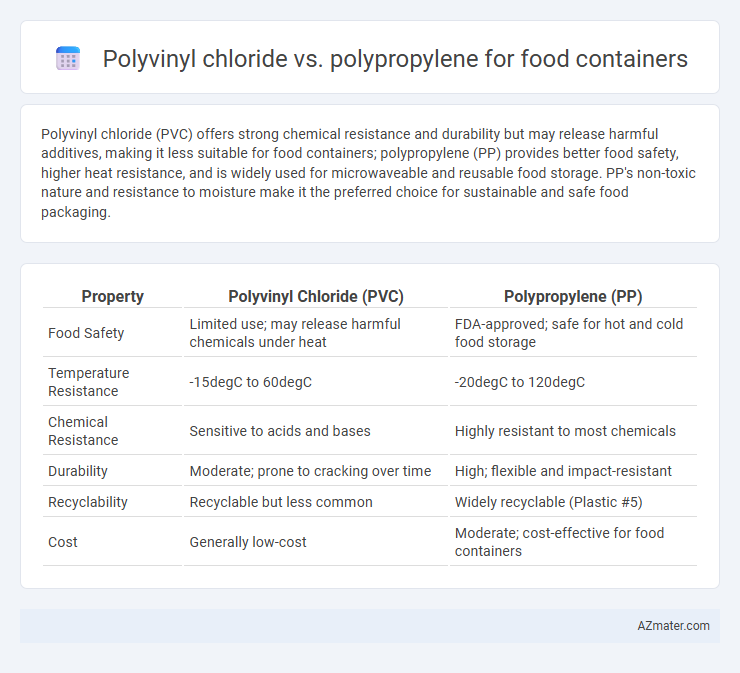Polyvinyl chloride (PVC) offers strong chemical resistance and durability but may release harmful additives, making it less suitable for food containers; polypropylene (PP) provides better food safety, higher heat resistance, and is widely used for microwaveable and reusable food storage. PP's non-toxic nature and resistance to moisture make it the preferred choice for sustainable and safe food packaging.
Table of Comparison
| Property | Polyvinyl Chloride (PVC) | Polypropylene (PP) |
|---|---|---|
| Food Safety | Limited use; may release harmful chemicals under heat | FDA-approved; safe for hot and cold food storage |
| Temperature Resistance | -15degC to 60degC | -20degC to 120degC |
| Chemical Resistance | Sensitive to acids and bases | Highly resistant to most chemicals |
| Durability | Moderate; prone to cracking over time | High; flexible and impact-resistant |
| Recyclability | Recyclable but less common | Widely recyclable (Plastic #5) |
| Cost | Generally low-cost | Moderate; cost-effective for food containers |
Introduction: Comparing Polyvinyl Chloride and Polypropylene
Polyvinyl chloride (PVC) and polypropylene (PP) are two commonly used plastics for food containers, each with distinct chemical compositions and properties affecting food safety and durability. PVC offers excellent clarity and flexibility, making it suitable for packaging requiring visibility and form-fitting seals, but it may release harmful additives if not properly formulated. Polypropylene is renowned for its high heat resistance, chemical stability, and inertness, ensuring safer long-term storage and microwave use without compromising food quality.
Key Properties of Polyvinyl Chloride (PVC)
Polyvinyl chloride (PVC) is widely used in food containers due to its excellent chemical resistance, durability, and strong barrier properties against moisture and gases, which help preserve food freshness. PVC offers high clarity and rigidity, making it an ideal material for transparent and sturdy packaging. Its thermal stability supports a broad range of temperatures, although it may release harmful additives if heated excessively, requiring strict compliance with food safety standards.
Key Properties of Polypropylene (PP)
Polypropylene (PP) offers superior chemical resistance, making it ideal for food containers that require durability against oils, acids, and alkalines. Its high melting point of around 160degC allows safe use in microwave heating and dishwasher cleaning without deformation. The material's excellent fatigue resistance and low moisture absorption ensure long-lasting strength and hygiene for food storage applications.
Safety Considerations for Food Contact
Polyvinyl chloride (PVC) contains additives such as plasticizers and stabilizers that may leach harmful chemicals into food, raising safety concerns for food contact applications. Polypropylene (PP) is widely regarded as safer due to its chemical inertness, high heat resistance, and low likelihood of contaminant migration, making it a preferred choice for food containers. Regulatory agencies like the FDA and EFSA approve polypropylene for direct food contact, emphasizing its compliance with stringent safety standards.
Chemical Resistance and Reactivity
Polyvinyl chloride (PVC) offers moderate chemical resistance but can release harmful additives such as phthalates when exposed to acidic or fatty foods, raising safety concerns for food storage. Polypropylene (PP) exhibits superior chemical resistance with high stability against acids, bases, and oils, making it a safer choice for food containers that come into contact with diverse food types. PP's low reactivity and resistance to leaching chemicals ensure better food preservation and compliance with food safety regulations.
Durability and Lifespan in Food Storage
Polyvinyl chloride (PVC) offers moderate durability with good resistance to oil and fat, but it may degrade over time when exposed to heat or acidic foods, limiting its lifespan in long-term food storage. Polypropylene (PP) boasts superior durability, with high resistance to heat, chemicals, and repeated washing, ensuring a longer lifespan and better performance for food containers. In terms of longevity and maintaining food safety, polypropylene outperforms polyvinyl chloride as the preferred material for durable, reusable food storage solutions.
Environmental Impact and Recyclability
Polyvinyl chloride (PVC) poses significant environmental challenges due to the release of harmful dioxins during production and incineration, making it less eco-friendly compared to polypropylene (PP), which has a lower toxicity profile. Polypropylene offers better recyclability, with established recycling streams and higher rates of successful material recovery, reducing landfill contributions. PP's lighter weight also lowers transportation emissions, enhancing its overall environmental sustainability for food container applications.
Cost Analysis: PVC vs PP Containers
Polyvinyl chloride (PVC) containers typically have lower initial costs compared to polypropylene (PP) containers, making them a budget-friendly option for food packaging. However, polypropylene offers better chemical resistance and durability, which can reduce long-term replacement expenses. When analyzing total cost of ownership, polypropylene's higher upfront price may be offset by extended lifespan and improved safety for food storage.
Common Applications in the Food Industry
Polyvinyl chloride (PVC) is commonly used in food packaging such as cling films, blister packs, and shrink wraps due to its excellent moisture barrier and transparency. Polypropylene (PP) is favored for reusable food containers, microwaveable trays, and bottles because of its high heat resistance, chemical stability, and durability. Both materials play crucial roles in food safety and preservation, with PVC often chosen for single-use packaging and PP preferred for applications requiring repeated usage or heat exposure.
Final Recommendation: Choosing the Right Material
Polypropylene (PP) is generally recommended over Polyvinyl Chloride (PVC) for food containers due to its superior chemical resistance, higher heat tolerance up to 110degC, and safer food-grade properties, minimizing risks of harmful plasticizers leaching into food. PVC, while durable and flexible, often contains additives like phthalates that may pose health concerns, making it less ideal for direct food contact applications. Selecting polypropylene ensures better durability, safety, and compliance with food safety standards for containers used in reheating or long-term food storage.

Infographic: Polyvinyl chloride vs Polypropylene for Food Container
 azmater.com
azmater.com